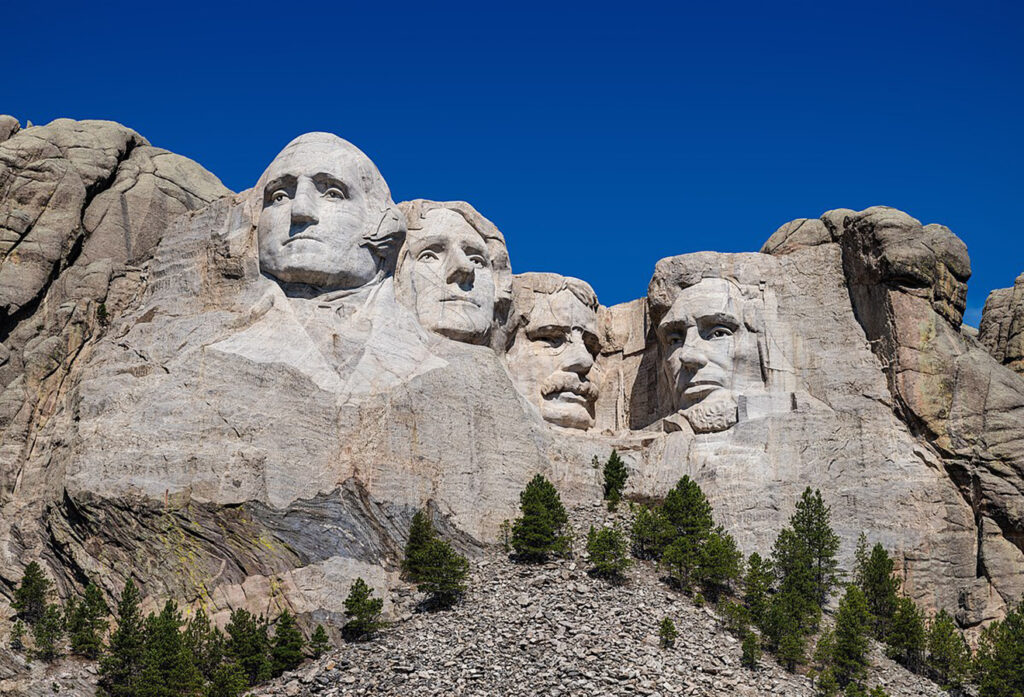Mt. Rushmore View of Former Play-By-Play Broadcasters

Mount Rushmore in South Dakota has great majestic symbolism for our country.
I notice that more and more people use Mount Rushmore to represent greatness in a wide variety of ranking the best of the best in almost any field of endeavor.
So why not join the growing crowd?
Thus, I will present my personal Mount Rushmore for my own profession, network play-by-play broadcasting in the four major professional sports.
The man on the far left would be Vin Scully, arguably the greatest baseball announcer of all-time.
Vin Scully
I believe this would be the only category that would be uncontested.
I first heard the golden tones of Scully when he was the third man in the Brooklyn Dodgers booth in the 50’s.
He was top-notch right out of the gate.
Ultimately he rose to #1 while the Dodgers still played in Brooklyn.
But it was when the Dodgers moved to Los Angeles in 1958, when Vin began to establish his iconic style that made him a true legend.
In reality, he “taught” LA fans Major League Baseball.
The crowd, first at the Coliseum, then at Dodger Stadium, came equipped with transistor radios.
The fans were there to see the games in person, but they needed their friend to enhance what they were witnessing.
The sound emanating from the radios echoed throughout the stadium. Even the players heard the commentary.
It was a way of life for Dodger baseball.
Scully’s melodious voice, describing the action precisely, while sprinkling personal notes about the players, was unmatched.
He was the voice of the Dodgers for 67 seasons, and called 28 World Series, as broadcasting record.
Next to Vin Scully would be Al Michaels, in my view the finest play-by-play television voice to broadcast the NFL.
Al Michaels
There have been other contenders, of course, including Pat Summerall and Dick Enberg, who will be mentioned again later. But Michaels, the only member of Mt. Rushmore still behind the mike, gives an account of every game he broadcasts, with authority, and the ability to put the story of the game in perfect perspective.
Of course, Al has done the same for every sport he’s handled, so it’s no surprise.
This summer, he was honored by Major League Baseball, capturing the Ford Frick award, MLB’s broadcasting Hall of Fame.
As an aside, Michaels has always had subtle comments on point-spreads and other betting features, startling to some in years past, but par for the course in today’s increased television emphasis on gambling.
He will be at the microphone for his seventh Super Bowl next February.
Facing the magnificent sculpture, the next man would be Marv Albert, the acclaimed NBA broadcaster.
Marv Albert
Featuring a voice unlike practically all the other greats, Marv’s presence was instantly evident whenever anyone tuned into pro basketball.
His throaty, staccato delivery was ideal for his sport.
His exclamation of “YES” on key successful outside shots became his trademark.
He began as the voice of the New York Knicks on local radio and TV after serving as their ballboy in high school, then was the sound of practically all of Michael Jordan’s Chicago Bulls dominant seasons.
Marv and I have broadcast eight NBA Finals.
The record is held by the current national voice, Mike Breen, with 14.
Finally, on the far right, the man wearing glasses, is Mike Emrick.
Mike Emrick
Emrick, in my view, may just be the class of the group considering the sport broadcasts, and how easy he makes it sound.
Hockey play-by-play is a particularly challenging assignment.
It is lightning fast, punctuated by constant line changes, with personnel coming on and off the ice Add to that, keeping track of the puck, and the flow of the game, makes NHL announcing an art.
Emrick retired earlier this year having announced 22 Stanley Cup Finals overall, more than anyone else.
His ability to weave in pertinent stories, while giving the broadcast room to breathe without wall-to-wall talk is remarkable.
There have been many other first-rate NHL TV play-by-players. Of course, it all started with Canadians, such as Bob Cole, Danny Gallivan, and Foster Hewitt.
The top Americans have been Dan Kelly, Jiggs McDonald, and lately, Kenny Albert.
But Mike Emrick is tops, and he earns a spot on Mt. Rushmore.
How about the other sports? The college broadcasters, as well as the Hosts. So, with tongue planted firmly in cheek, I’ve discovered a second Mt. Rushmore, believe it or not.
It happens to be in NORTH Dakota, amazingly enough!
And it happens to display four more broadcasters.
Let’s start with Keith Jackson, the iconic voice of college football.
When he was the sport’s lead announcer, a college football broadcast was not a broadcast without Keith Jackson calling the plays.
With a deep baritone delivery, and the use of familiar descriptions, Jackson enhanced the games in brilliant fashion.
How about when a player coughed up the ball.
“FUUMMBLE”. Jackson would intone.
He called the huge linemen, “big uglies”.
And that was just the start.
On the college hoop side, I see Dick Enberg on the Mount.
Enberg was the opposite of Keith Jackson.
He was authoritative yes, but softer in his delivery, adding personal notes where it fit.
Enberg was the radio voice of the UCLA dynasty of John Wooden.
What a way to begin a play-by-play career.
And like so many others honored here, Enberg excelled in more than one sport. And like so many of the others, was a prime candidate to be the best in those sports as well.
When we watch golf broadcasts, our attention is focused more on the experts, the former players who analyze the action.
Sometime in the future, we will do a Mt. Rushmore view of the former players and coaches who work with the play-by-play guys.
But for golf broadcasting, I believe Pat Summerall stands out to have his visage forever on the mountain.
Summerall, of course, was a lead telecaster in the NFL, as well as golf and tennis. Pat led CBS’ long-time coverage of the U.S. Open tennis championship, the final event of the Grand Slam every year.
The mark of any Pat Summerall broadcast was a deep, strong voice, and a minimum of talk. Summerall’s style enhanced everything he covered like no one else.
It’s a lost art today.
Finally, the hosts, the faces of those who led-off the big events, and sent us to the venues of competition in effortless and fluid fashion.
Remember, Jim McKay at the many Olympics ABC covered?
McKay was also the host of that network’s Wide World of Sports.
He always said whenever he spoke, he was, in reality, talking to only one person. That’s the way it appeared.
McKay was calm, human, believable, and effective.
He was one-of-a-kind.
There have been other outstanding hosts, for sure.
Bob Costas and Brent Musburger stand out.
But I’ll put Jim McKay up there on my faux Mt. Rushmore.
Let’s not forget the real thing.
The actual Mount Rushmore, the National Memorial carved into the mountain in the Black Hills near Keystone, South Dakota. The project’s execution from 1927 to 1941 featuring the 60-foot heads of Presidents George Washington, Thomas Jefferson, Theodore Roosevelt, and Abraham Lincoln.
They were chosen to represent the nation’s birth, growth, development and preservation respectively.
Let’s not forget.




